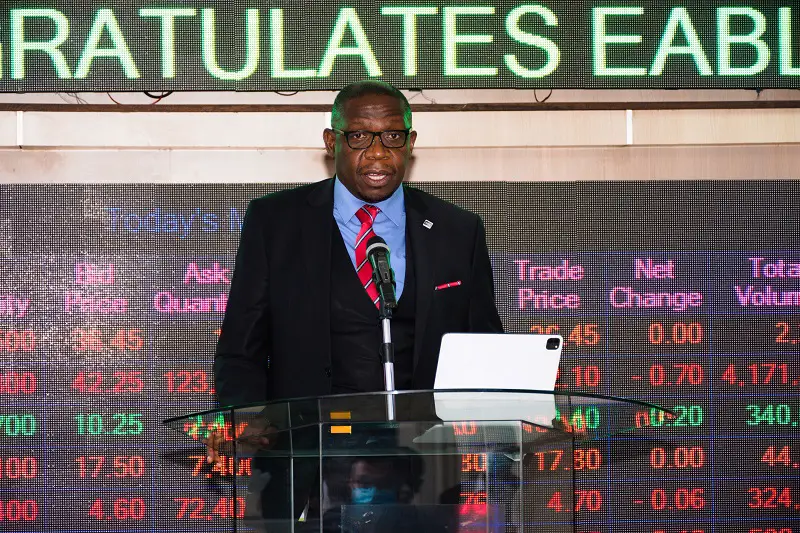- The Nairobi Securities Exchange (NSE) Share Value dropped from from US$60.3 million in September 2022 to US$33.3 million in September 2023.
- The NSE 20 Share Index also declined from 1,718 points in September 2022 to 1,508 points recorded in September 2023.
- Nairobi bourse hit by turbulence as investor sell off persisted in favour of other lucrative markets in the nine months to September 2023.
The Nairobi Securities Exchange took a hit in the past year losing US$26.9 million (KSh4.2 billion) in the value of shares traded to reach US$33.33 million (KSh5.2 billion).
Latest data contained in the Quarterly Gross Domestic Product Report released by Kenya National Bureau of Statistics (KNBS) shows that despite the drop, the number of shares traded recorded a rise.
The review period saw the Nairobi bourse hit by turbulence as investor sell off persisted in favour of other lucrative markets, this saw NSE ranked the worst performing market globally.
Higher returns on bonds in advanced markets attracted foreign investors from frontier markets such as the NSE over the last year, as they view such securities as safe havens in times of global uncertainty.
“The Number of shares traded in the Nairobi Securities Exchange increased from 351 million in September 2022 to 424 million in September 2023 but the total value of shares traded declined from Sh9.4 billion in September 2022 to Sh5.2 billion in September 2023,” KNBS said in an update.
The NSE 20 Share Index also declined from 1,718 points in September 2022 to 1,508 points in the third quarter ended September 2023.
In the review period, major stocks took a hit mostly on sell-off of Safaricom PLC and lender KCB Group counters by foreign funds chasing higher returns in developed markets.
How Kenya Shilling Performance impacted NSE Share Value
The Kenyan Shilling depreciated against all major international trading currencies in the third quarter of 2023 compared to the corresponding three month period in 2022.
On average, the Kenyan Shilling ceded ground against the Euro, Pound Sterling, US Dollar and Japanese Yen by 30.3 per cent, 29.7 per cent, 20.6 per cent, and 15.3 per cent, respectively.
The local currency also notably depreciated against South African Rand, and regional currencies Tanzania Shilling as well as Uganda Shilling.
However, things are looking up for the local currency as a reduction in the demand and an increase in the supply of dollars in the economy this December have seen the shilling’s rate of depreciation drop to its lowest level since the start of the year.
Data from the Central Bank of Kenya (CBK) indicates that since the beginning of December, the shilling has lost three cents on average against the dollar, as opposed to an average loss of 12 cents per day in November and 13 cents in October.
[Photo / Nation.africa]
Read also: Low volumes mark opening of Nairobi Securities trading
Kenya’s GDP
The KNBS report shows that Kenya’s real Gross Domestic Product (GDP) grew by 5.9 per cent in the third quarter of 2023 despite a challenging micro economic environment and free falling shilling that among others impacted business operations.
This is an expansion from 4.3 per cent in the corresponding quarter of 2022, majorly supported by a turnaround in the output of sectors such as agriculture, forestry and fishing.
According to KNBS, during the review quarter, agriculture, forestry, and fishing activities’ Gross Value Added rose by 6.7 per cent from a contraction of 1.3 per cent in the third quarter of 2022.
In addition, the growth was also buoyed by significant growths in financial and insurance (14.7per cent), information and communication (7.3 per cent) and accommodation and food service (26 per cent) activities.
The growth in accommodation and food activities was manifest in the significant increase in the number of visitor arrivals in the country.
However, transportation and storage activities GVA decelerated from 5.1 per cent in the third quarter of 2022 to 2.8 per cent during the review period, partly attributable to high cost of petroleum fuels.
Financial and Insurance Sector Performance
KNBS says financial and insurance sector grew by 14.7 per cent in the third quarter of 2023 compared to 9.6 per cent in 2022. During the period under review, the Central Bank Rate was revised upwards to 10.50 per cent in September 2023 compared to 8.25 per cent in September 2022.
The cost of credit issued by commercial banks went up during the third quarter of 2023, with average interest rates on loans and other advances increasing to 13.98 per cent in September 2023, up from 12.41 per cent in September 2022.
Over the same period, the interbank rate increased from 4.36 per cent to 12.36 per cent. The average yield for 91-day Treasury Bills improved to an average of 14.38 per cent in September 2023 from an average of 8.92 per cent in September 2022, largely due to the depreciation of the Kenyan Shilling.
